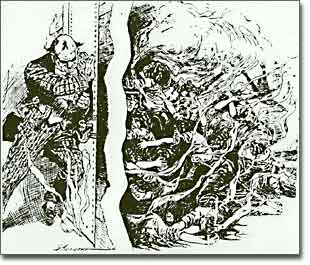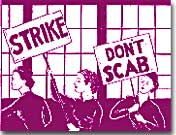37b. Labor vs. Management

The battle lines were clearly drawn. People were either workers or bosses, and with that strong identity often came an equally strong dislike for those who were on the other side. As the number of self-employed Americans dwindled in the Gilded Age, workers began to feel strength in their numbers and ask greater and greater demands of their bosses. When those demands were rejected, they plotted schemes to win their cases.
Those who managed factories developed strategies to counteract those of labor. At times the relationship between the camps was as intellectual and tense as a tough chess match. Other times it was as ugly as a schoolyard fight.
Strikes, Boycotts, and Sabotage
The most frequently employed technique of workers was the strike. Withholding labor from management would, in theory, force the company to suffer great enough financial losses that they would agree to worker terms. Strikes have been known in America since the colonial age, but their numbers grew larger in the Gilded Age.
Most 19th century strikes were not successful, so unions thought of other means. If the workers at a shoe factory could garner enough sympathy from the local townspeople, a boycott could achieve desirable results. The union would make its case to the town in the hope that no one would buy any shoes from the factory until the owners agreed to a pay raise. Boycotts could be successful in a small community where the factory was dependent upon the business of a group of people in close proximity
In desperate times, workers would also resort to illegal means if necessary. For example, sabotage of factory equipment was not unknown. Occasionally, the foreman or the owner might even be the victims of worker-sponsored violence.

"Strike, Don't Scab" Poster
Management Strikes Back
Owners had strategies of their own. If a company found itself with a high inventory, the boss might afford to enact a lockout, which is a reverse strike. In this case, the owner tells the employees not to bother showing up until they agree to a pay cut. Sometimes when a new worker was hired the employee was forced to sign a yellow-dog contract, or an ironclad oath swearing that the employee would never join a union.
Strikes could be countered in a variety of ways. The first measure was usually to hire strikebreakers, or scabs, to take the place of the regular labor force. Here things often turned violent. The crowded cities always seemed to have someone hopeless enough to "cross the picket line" during a strike. The striking workers often responded with fists, occasionally even leading to death.
Prior to the 20th century the government never sided with the union in a labor dispute. Bosses persuaded the courts to issue injunctions to declare a strike illegal. If the strike continued, the participants would be thrown into prison. When all these efforts failed to break a strike, the government at all levels would be willing to send a militia to regulate as in the case of the Great Upheaval.
What was at stake? Each side felt they were fighting literally for survival. The owners felt if they could not keep costs down to beat the competition, they would be forced to close the factory altogether. They said they could not meet the workers' unreasonable demands.
What were the employees demanding? In the entire history of labor strife, most goals of labor can be reduced to two overarching issues: higher wages and better working conditions. In the beginning, management would have the upper hand. But the sheer numbers of the American workforce was gaining momentum as the century neared its conclusion.






